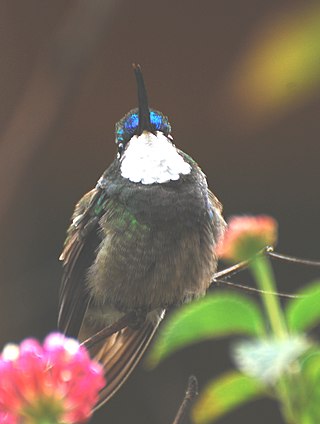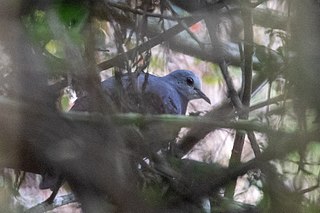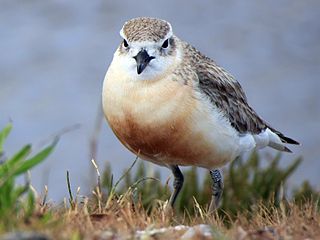
The family Vangidae comprises a group of often shrike-like medium-sized birds distributed from Asia to Africa, including the vangas of Madagascar to which the family owes its name. Many species in this family were previously classified elsewhere in other families. Recent molecular techniques made it possible to assign these species to Vangidae, thereby solving several taxonomic enigmas. The family contains 40 species divided into 21 genera.

Aquila is the genus of true eagles. The genus name is Latin for "eagle", possibly derived from aquilus, "dark in colour". It is often united with the sea eagles, buteos, and other more heavyset Accipitridae, but more recently they appear to be less distinct from the more slender accipitrine hawks than previously believed. Eagles are not a natural group, but denote essentially any bird of prey large enough to hunt sizeable vertebrate prey.

The grey-tailed mountaingem, also variously spelled gray-tailed mountaingem, grey-tailed mountain-gem, or gray-tailed mountain-gem, is a species of hummingbird in tribe Lampornithini of subfamily Trochilinae. It is endemic to Costa Rica.

The white-throated mountaingem or white-throated mountain-gem is a species of hummingbird in tribe Lampornithini of subfamily Trochilinae. It is endemic to Panama.

The sooty barbthroat is a hummingbird species in the family Trochilidae. It is found in Brazil and French Guiana.

The black-streaked puffbird is a species of near-passerine bird in the family Bucconidae, the puffbirds, nunlets, and nunbirds. It is found in Bolivia, Colombia, Ecuador, and Peru.

The Hispaniolan nightjar is a nightjar species endemic to the Caribbean island of Hispaniola, which is shared by the Dominican Republic and Haiti.

The maroon-chested ground dove is a species of bird in the family Columbidae. It is found in Bolivia, Colombia, Costa Rica, Ecuador, El Salvador, Guatemala, Honduras, Mexico, Panama, Peru, and Venezuela.

Archbold's newtonia is a species of bird in the family Vangidae. It is endemic to Madagascar. Its natural habitats are subtropical or tropical dry forests and subtropical or tropical dry shrubland. The birds have a greyish brown back and tail, with a rufous forecrown and a buffy white belly, throat, and undertail coverts. They have a conspicuous rufous eye-ring, accompanied with a black bill and pale yellow eyes. The species is sexually monomorphic, and there is no major difference between the sexes. There is no breeding plumage for the males.

The common newtonia is a species of bird in the family Vangidae. It is endemic to Madagascar.
The red-tailed newtonia is a species of bird in the family Vangidae. It is endemic to Madagascar.

The Malagasy paradise flycatcher is a species of bird in the family Monarchidae. It is found in Comoros, Madagascar, and Mayotte. Its natural habitats are subtropical or tropical dry forest and subtropical or tropical moist lowland forest.

The spotted woodcreeper is a species of bird in the subfamily Dendrocolaptinae of the ovenbird family Furnariidae. It is found in Belize, Colombia, Costa Rica, Ecuador, El Salvador, Guatemala, Honduras, Mexico, Nicaragua, and Panama.

The grey-crowned woodpecker is a species of bird in subfamily Picinae of the woodpecker family Picidae. It is endemic to western Mexico.

Newtonia is a genus of passerine birds containing four to five species. They were formerly classified in the Old World warbler family Sylviidae or Old World flycatcher family Muscicapidae but have recently been shown to belong to the vanga family Vangidae. They are endemic to Madagascar where they occur in forest or scrubland. They forage in pairs for insects, often joining mixed-species feeding flocks.

Zahamena National Park is a national park of Madagascar. Established in 1997, it covers an area of 423 square kilometres (163.32 sq mi) out of a total protected area of 643 square kilometres (248.26 sq mi). It is part of a UNESCO World Heritage Site, Rainforests of the Atsinanana, inscribed in 2007 and consisting of 13 specific areas located within eight national parks in the eastern part of Madagascar. In 2001, Bird Life International assessed avifauna of 112 species of which 67 species are exclusively endemic to Madagascar.
The pale-throated wren-babbler is a bird species in the family Timaliidae. It was until recently considered a subspecies of the long-tailed wren-babbler; the IUCN for example started recognizing it as distinct species in 2008. It is endemic to Vietnam

The Diamantina tapaculo is a species of bird in the family Rhinocryptidae. It is endemic to northeastern Brazil.

The northern New Zealand dotterel or northern red-breasted plover is a shorebird which breeds exclusively on beaches in New Zealand's North Island.
The southern dark newtonia is a species of bird in the family Vangidae. It is endemic to the montane forests of southeastern Madagascar, from Andringitra south to Tolagnaro. It was formerly considered a population of the dark newtonia, but was split from it in 2018 and classified as a distinct species after an analysis of physical and genetic differences from N. amphichroa, most notably its longer tail. However, some authorities such as The Clements Checklist of Birds of the World have supported tentatively classifying N. lavarambo as a subspecies of N. amphichroa rather than a distinct species.


















